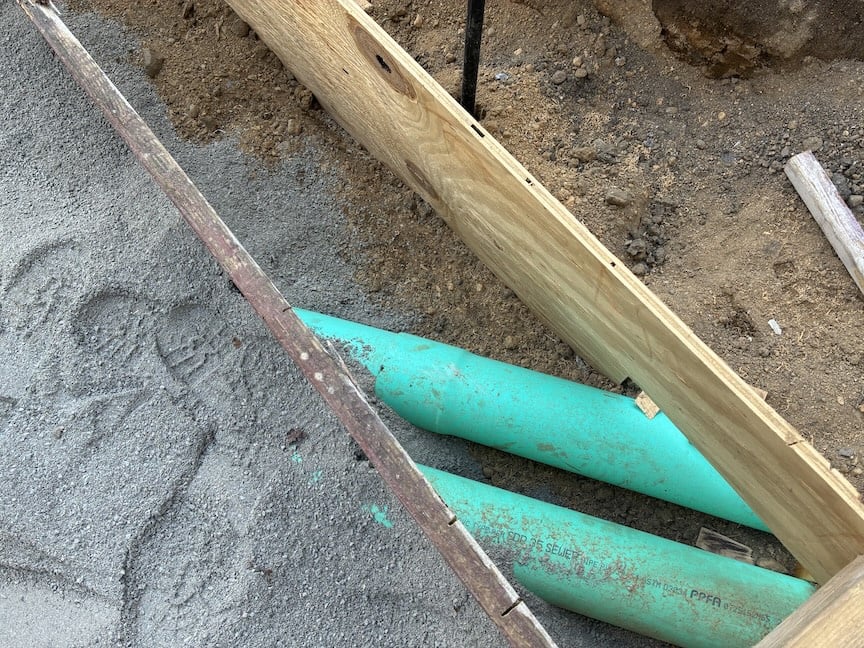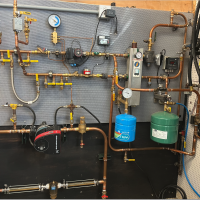Outside Drainage: PVC best pipe direction male spigot into female bell--in direction of water flow?
I just noticed this piping joint. Water direction would be flowing to the left. Is this not the wrong connection? Possibly causing leakage? I'll also mention they are not gluing these joints; I know sometimes reasons for that.
Info online has said that for flow, bell direction does not matter, only for the installation.
PS Flow direction is one thing, but suppose they installed this opposite the flow direction but with spigot going into bell, from the left to the right? (I kind of doubt they did.) That would be a tighter install, yes?
Comments
-
-
-
Thanks. this is just SDR35 I believe; this is storm drainage so will be empty most of the time. MIGHT be O-rings on the Ys or elbows…..
0 -
Seems to me it's mostly a matter of which direction are you going in laying the pipe… it's an awful lot easier to insert the male end of the new section into the bell of the previously laid section, so… which end of the line did you start at?
Br. Jamie, osb
Building superintendent/caretaker, 7200 sq. ft. historic house museum with dependencies in New England0 -
What's in the photo is closer to the cultec than the eventual drain box outlet about 60 ft to the left. So it would appear to be the wrong way to do it in terms of installation. Though I've heard the hydraulics are not affected it would seem that inserting the male into the bell provides less chance of leaking —the way that the upper male storm leader fits inside the lower leader. Anyway this may be moot as they have laid this out already.
0 -
if it is perforated pipe, a small leak would not matter
Ideally it should be glued
For pressure applications or sewer, it is usually the o ring type pipe
Bob "hot rod" Rohr
trainer for Caleffi NA
Living the hydronic dream0 -
Not perforated pipe. It's not glued—I've seen some opinions that gluing makes the piping setup more rigid when it sometimes requires more pliancy. They also don't believe in tamping the pipe trench owing to its being 'virgin soil.' I think this will be ok, but if I had to do it again, I would hire draining specialists.
0 -
-
Ah yes. Bedding. Any buried pipe should be bedded in sand, but it doesn't need that much for small pipe. Further, the SIDES need to be tamped and one should make sure that the pipe is supported all around.
Now… if it is three feet under your lawn, no big deal. If it's a foot under your driveway, big deal. Because it is the tamping around the sides which keeps the pipe in shape…
Br. Jamie, osb
Building superintendent/caretaker, 7200 sq. ft. historic house museum with dependencies in New England1 -
The driveway will have about 14" of underlayers: 10" gravel, a few inches of sand, geogrid etc. Pipe is SDR 35. 8" footings on either side for soldier course to keep everything together…
0 -
Ought to work… a lot better than some I've got on the farm!
Br. Jamie, osb
Building superintendent/caretaker, 7200 sq. ft. historic house museum with dependencies in New England0 -
If it is storm drainage, as you mentioned, it's not a big concern. If it were a sanitary drain, then it would be because, as mentioned above, roots would search out that joint to find the nutrients. It should work fine as is.
0
Categories
- All Categories
- 87.3K THE MAIN WALL
- 3.2K A-C, Heat Pumps & Refrigeration
- 61 Biomass
- 427 Carbon Monoxide Awareness
- 119 Chimneys & Flues
- 2.1K Domestic Hot Water
- 5.8K Gas Heating
- 114 Geothermal
- 165 Indoor-Air Quality
- 3.7K Oil Heating
- 76 Pipe Deterioration
- 1K Plumbing
- 6.5K Radiant Heating
- 395 Solar
- 15.6K Strictly Steam
- 3.4K Thermostats and Controls
- 56 Water Quality
- 51 Industry Classes
- 50 Job Opportunities
- 18 Recall Announcements




